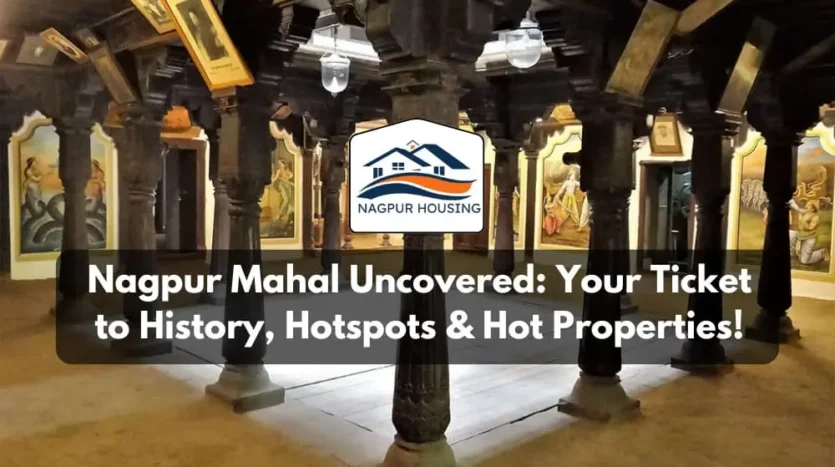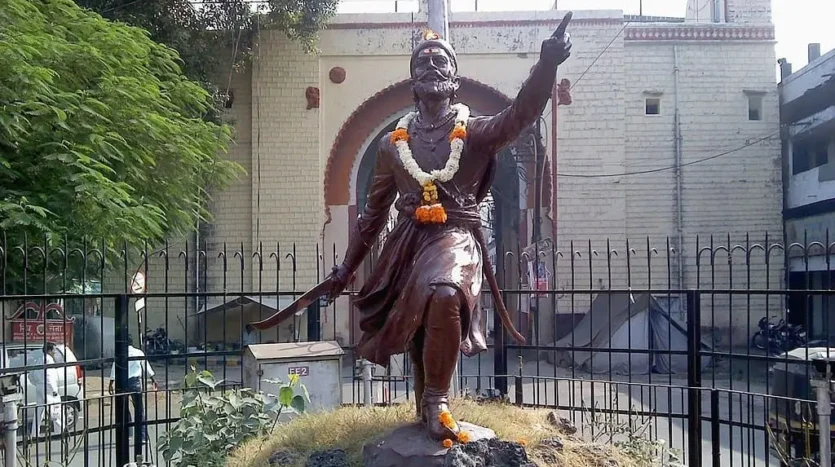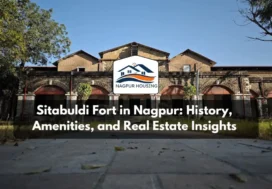Nagpur Mahal Uncovered: Your Ticket to History, Hotspots & Hot Properties!
Nagpur, fondly known as the “Orange City,” is a vibrant metropolis in the heart of India, and at its core lies Mahal, one of the oldest and most culturally rich neighborhoods. Mahal is more than just a locality; it’s a living testament to Nagpur’s historical legacy, bustling present, and promising future. Whether you’re a local looking to rediscover your roots, a potential resident eyeing a property, or a visitor planning a trip, this blog post dives deep into everything you need to know about Nagpur Mahal. From its storied past to modern amenities, nearby hotels, real estate trends, quick facts, and future plans, let’s take a journey through this iconic part of Nagpur.
You might like: Nagpur Airport: History, Amenities & Future Plans Unveiled
About Nagpur Mahal: A Glimpse into Its History
Mahal is the historic heart of Nagpur, often referred to as the “old city.” Its name is tied to the very origins of Nagpur, a city whose history stretches back centuries. Here’s a summary of its historical significance:
- Origins and Naming: The name “Nagpur” is believed to derive from the Nag River, which flows through the city. Mahal, situated on the north banks of this river, was the original settlement that grew into modern Nagpur. Some historians suggest the city was named after the “Nags,” a community mentioned in ancient texts, while others link it to the Marathi word “phaṇa” (cobra’s hood), referencing local folklore.
- Gond Kingdom and Maratha Rule: Founded in the early 18th century by Gond King Bakht Buland Shah, Nagpur became a significant center under the Bhonsle rulers of the Maratha confederacy. Mahal, as the core of the city, was home to palaces, forts, and bustling markets. The Bhonsles’ reign saw Mahal flourish as a political and commercial hub.
- British Era: In 1817, Nagpur came under British influence after the Battle of Sitabuldi, fought near Mahal. By 1853, the city was fully under British control, and Mahalthe city was renamed “Nagpore.” Mahal remained a central administrative area, with landmarks like the Sitabuldi Fort becoming symbols of British rule.
- Post-Independence: After India’s independence in 1947, Nagpur became the capital of the Central Provinces and Berar, and later part of Maharashtra in 1960. Mahal continued to be a cultural and commercial hub, with its narrow lanes and historic buildings preserving the city’s heritage.
- Cultural Significance: Mahal is home to significant cultural and religious sites, such as the Jhajjar Bagh (now Mominpura), established by Urdu and Persian scholars during the Bhonsle era, and the Nagpur Central Museum, established in 1863, which showcases Vidarbha’s heritage.
Mahal’s history is a blend of royal legacy, colonial influence, and modern vibrancy, making it a must-visit for anyone exploring Nagpur’s roots.
Amenities at Nagpur Mahal
Mahal is not just a historical gem; it’s a well-equipped locality offering modern amenities that cater to residents and visitors alike. Here’s a rundown of what you can expect:
- Educational Institutions: Mahal is home to reputed schools like Shri Rajendra School, Gayatri High School, and Sane Guruji School. For higher education, institutions like Bhosla Ved School, Sindhu Mahavidyalaya, and Maharashtra Adhyapak Vidyalaya are nearby, making it ideal for families.
- Healthcare Facilities: Access to quality healthcare is a breeze with hospitals like Matru Sewa Sangh Maternity Hospital, Saboo Hospital, and Prabhakar Datake Hospital within a 1-km radius. The Nagpur Municipal Corporation also runs diagnostic centers and outpatient dispensaries in the area.
- Shopping and Entertainment: Mahal’s bustling markets, such as Kifayat Baazar, offer everything from clothes to household goods. For a modern shopping experience, Fortune Mall and PVR Express City Mall are close by, providing entertainment and dining options.
- Parks and Recreation: Chitnis Park, a popular green space, is perfect for morning walks or family outings. Other nearby parks add to the area’s appeal for those seeking relaxation.
- Connectivity: Mahal’s central location ensures excellent connectivity. It’s just 1.2 km from the Armori-Nagpur Highway, 1.3 km from Chitnis Park Bus Stop, and 1.6 km from Gulfam Pan Mahal railway station. Nagpur Junction is less than 5 km away, and Dr. Babasaheb Ambedkar International Airport is about 10.3 km. The Nagpur Metro further enhances accessibility with nearby stations.
- Religious and Cultural Sites: Mahal is dotted with temples, mosques, and historical landmarks. The Jhajjar Bagh Masjid and the Namantar Shahid Smarak, commemorating the Dalit movement, are notable sites.
- Safety and Security: Residents praise Mahal for its safe and secure environment, with proximity to essential services like banks, post offices, and police stations.
These amenities make Mahal a self-sufficient locality, blending the charm of old Nagpur with the conveniences of modern living.
Hotels Near Nagpur Mahal
For visitors, Mahal’s central location offers a range of accommodation options, from budget-friendly to luxury stays. Here are some notable hotels nearby, with approximate distances and key features:
- Hotel Anand Mahal (0.5 km from Mahal): Located on Temple Bazar Road, Sitabuldi, this 3-star hotel offers spacious rooms with premium bedding, tea-coffee makers, and minibars. Guests appreciate its central location, friendly staff, and in-house restaurant. Rates start at around ₹1,500 per night.
- Hotel Centre Point (1.5 km, Dhantoli): A business-friendly hotel with 120 well-maintained rooms, internet access, and proximity to Dhantoli Park. Ideal for corporate travelers, with rates starting at ₹2,500 per night.
- Radisson Blu Hotel (7 km, Wardha Road): A 5-star option for those seeking luxury, just a 10-minute drive from the airport. It features a spa, swimming pool, gym, and stylish rooms. Rates start at ₹6,000 per night.
- Le Meridien Nagpur (8 km, Wardha Road): Another upscale choice with excellent service, modern decor, and gourmet dining. Perfect for leisure and business travelers, with rates from ₹5,500 per night.
- Treebo Hotel Rk Inn (2 km, near Nagpur Train Station): A budget-friendly option with clean rooms, free parking, and proximity to public transport. Rates start at ₹1,200 per night.
- Hotel Heritage 2001 (2.5 km, Ganesh Peth): A budget hotel with basic amenities, ideal for short stays. Rates start at ₹1,000 per night.
Booking through platforms like Yatra.com or MakeMyTrip can fetch discounts of up to 30-45% with free cancellation options. Many hotels are pet-friendly, couple-friendly, and offer complimentary breakfast.
Properties for Sale Near Nagpur Mahal with Property Rates
Mahal’s real estate market is thriving, thanks to its central location and robust infrastructure. Whether you’re looking for flats, houses, or plots, here’s a summary of available properties and their rates as of June 2024:
- Flats/Apartments:
- 1 BHK: A 650 sq.ft. 1 BHK flat in Mahal, behind Nataraj Talkies, is listed for ₹25 lakh. Features include an open terrace and fixed furniture.
- 2 BHK: A 760 sq.ft. 2 BHK in Manish Krutika Residency, centrally located, costs ₹45 lakh. It has 3 balconies and is ready to move.
- 3 BHK: A 1,600 sq.ft. 3 BHK in Kamgar Nagar, near Ramna Maroti Mandir, is priced at ₹71 lakh, offering luxury amenities like parking and security.
- Average Rate: ₹5,000–₹7,000 per sq.ft., with rental yields around 4% annually.
- Houses/Villas:
- 1 BHK House: A 650 sq.ft. independent house in Pardi, near Mahal, is available for ₹50 lakh. It’s ready to move with 2 bathrooms.
- 3 BHK House: A 1,200 sq.ft. 3 BHK villa in Mahal is listed for ₹60 lakh, featuring modern amenities and a corner plot.
- 12 BHK House: A massive 4,900 sq.ft. independent house with 12 bedrooms and multiple balconies is priced at ₹2 crore, ideal for large families or redevelopment.
- Average Rate: ₹6,000–₹10,000 per sq.ft., depending on age and amenities.
- Plots/Land:
- Residential Plot: An 8-acre freehold plot in Mahal is available for ₹20 lakh, ideal for large-scale development.
- Prime Plot: A 1,300 sq.ft. plot in nearby MIHAN, 7 km from Mahal, costs ₹21.7 lakh, with authority approval and bank loan options.
- Average Rate: ₹1,500–₹3,000 per sq.ft., with high appreciation potential due to infrastructure growth.
- Key Localities for Investment: Besides Mahal, nearby areas like Dhantoli (58.5% price growth in 3 years), Medical Square (5.8% rental yield), and Besa (3.7% rental yield) are hotspots.
- New Projects: KS Gill Crest Apartment and Guru Srinivasa Apartments in Mahal offer modern flats with amenities like lifts, parking, and 24/7 security.
Mahal’s properties are in demand due to their proximity to schools, hospitals, and metro stations. Platforms like 99acres.com and Magicbricks.com list over 35 properties in Mahal, with 30+ ready-to-move options.

Quick Facts on Nagpur Mahal
Here’s a snapshot of Mahal for quick reference:
- Location: Central Nagpur, on the north banks of the Nag River.
- Population: Part of Nagpur’s 2.4 million urban population (2011 Census).
- Connectivity: 5 km from Nagpur Junction, 10.3 km from the airport, and 1.2 km from the Armori-Nagpur Highway.
- Key Landmarks: Sitabuldi Fort, Jhajjar Bagh, Namantar Shahid Smarak, Nagpur Central Museum.
- Amenities: 25+ schools, 10+ hospitals, multiple parks, malls, and metro access.
- Property Rates: Flats: ₹5,000–₹7,000/sq.ft.; Houses: ₹6,000–₹10,000/sq.ft.; Plots: ₹1,500–₹3,000/sq.ft.
- Cultural Events: Hosts the Marbat Festival, where effigies of evil forces are burned to protect the city.
- Safety: Rated as a safe locality with low crime rates and proximity to police stations.
Mahal’s blend of history, amenities, and connectivity makes it a cornerstone of Nagpur’s identity.
Expansion of Nagpur Mahal and Future Government Plans
Nagpur is on a fast track to becoming a global city, and Mahal, as its historic core, is poised to benefit from ongoing and planned developments. Here’s what’s in store:
- Nagpur Metro Expansion: The Nagpur Metro’s Orange and Aqua lines, operational since 2019, connect Mahal to areas like Sitabuldi and Khapri. Future phases will add more stations, improving intra-city travel. The metro project, costing ₹8,260 crore, aims to make Nagpur a model for sustainable urban transport.
- MIHAN SEZ Growth: The Multi-Modal International Cargo Hub and Airport at Nagpur (MIHAN), 7 km from Mahal, is a game-changer. It’s attracting IT companies, logistics firms, and manufacturing units, boosting job opportunities and property demand in Mahal.
- Smart City Initiatives: Nagpur is one of Maharashtra’s Smart Cities, with investments in digital infrastructure, e-governance, and green energy. Mahal’s markets and public spaces are being upgraded with smart lighting and Wi-Fi zones.
- Airport Upgrades: Dr. Babasaheb Ambedkar International Airport, handling over 1 million passengers annually, is slated for expansion and privatization. This will enhance Nagpur’s global connectivity, benefiting Mahal’s hospitality sector.
- Zero Mile Redevelopment: The Zero Mile Stone, marking India’s geographic center, is near Mahal. Plans to develop it as a tourist hub with museums and cultural centers will draw visitors to the area.
- Healthcare Enhancements: The Nagpur Municipal Corporation, in collaboration with UNICEF and the WHO, is expanding health schemes. New diagnostic centers and hospitals in Mahal will improve resident access.
- Real Estate Boom: With 3,508+ properties listed for sale citywide, Mahal’s real estate is seeing steady growth. Areas like Dhantoli and Besa, adjacent to Mahal, are witnessing 35–58% price appreciation, signaling a robust market.
- Cultural Preservation: The government is restoring heritage sites like the Nagpur Central Museum and Jhajjar Bagh to promote tourism. Events like the Orange City LGBTQ Pride March and Marbat Festival will continue to highlight Mahal’s cultural vibrancy.
These initiatives position Mahal as a locality that balances heritage with progress, making it an attractive destination for residents, investors, and tourists.
Conclusion: Why Nagpur Mahal Matters
Nagpur Mahal is more than a neighborhood; it’s the soul of the Orange City. Its rich history, from Gond kings to British rule, tells the story of a city that has always been at the crossroads of culture and commerce. Today, Mahal offers a perfect blend of old-world charm and modern convenience, with top-notch amenities, excellent connectivity, and a thriving real estate market. Whether you’re looking to stay in a cozy hotel, invest in a property, or explore Nagpur’s heritage, Mahal has something for everyone.
As Nagpur evolves into a Smart City with ambitious projects like MIHAN and the Nagpur Metro, Mahal is set to shine even brighter. Its central location, coupled with government investments, ensures it remains a hub of opportunity and growth. So, whether you’re a Nagpurite proud of your city or a newcomer eager to explore, Mahal welcomes you with open arms. Visit its bustling markets, stroll through Chitnis Park, or marvel at the Sitabuldi Fort Mahal is where Nagpur’s past, present, and future come together.











